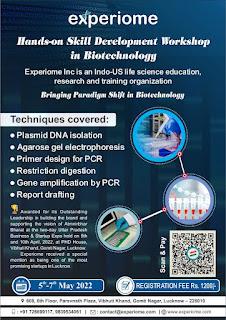Biotech Training and Research Lab in Uttar Pradesh | Biotech Course | Advanced Biotechnology | Experiome
Cloning and Recombinant DNA technology are same: Dilemma to be resolved
A clone is a group of unique cells or organisms that derive from a single progenitor in biology.
Because cell replication creates identical daughter cells every time, the individuals of a clone are
genetically identical. The term "clone" has been extended to recombinant DNA technology
(RDT), which allows scientists to make multiple copies of a single segment of DNA, such as a
gene, resulting in identical duplicates that make up a DNA clone. In practice, a DNA fragment is
inserted into a small DNA molecule, which is then allowed to proliferate inside a primitive live
cell such as a bacterium. A DNA vector is a tiny self-replicating molecule (carrier). Plasmids
(circular DNA molecules derived from bacteria), viruses, and yeast cells are the most commonly
used vectors. Plasmids are not part of the main cellular genome, but they can include genes that
provide the host cell valuable characteristics including drug resistance, mating ability, and toxin
production. They're small enough to manipulate easily in the lab, and they'll also carry extra
DNA that has been spliced into them. Uses of cloning are:
With biomedical procedures, DNA cloning can be utilised to create proteins like insulin.
It's employed to develop recombinant variants of the non-functional gene in order to
figure out how the regular gene works. This is also used in gene therapy.
It aids in determining the impact of a mutation on a certain gene.
Recombinant DNA refers to DNA molecules from two different species that are introduced into
a host organism to create new genetic combinations useful in science, medicine, agriculture, and
industry. Because the gene is at the core of all genetics, laboratory geneticists' primary purpose is
to extract, define, and modify genes. Although isolating a sample of DNA from a group of cells
is very simple, locating a specific gene within this DNA sample is comparable to finding a
needle in a haystack. Consider that each human cell has about 2 metres (6 feet) of DNA. As a
result, a tiny tissue sample can contain thousands of kilometres of DNA. Recombinant DNA
technology has made it possible to isolate a single gene or other section of DNA, allowing
researchers to establish its nucleotide sequence, investigate its transcripts, alter it in extremely
specific ways, and reintroduce the transformed sequence into a living organism. Uses of RDT
are:
In agriculture, recombinant DNA technology is frequently used to produce genetically
modified organisms such as Flavr Savr tomatoes, Golden Rice, Bt-cotton to protect plants
from bollworm, and many others. Advanced Biotechnology
Human insulin is made using recombinant DNA technology in the pharmaceutical
industry.
In clinical diagnosis.
What students need to grasp is that recombinant DNA technology and DNA cloning are not the
same. Advanced Biotechnology
We at Experiome offer hands-on training and learning opportunities to students in the area of
recombinant DNA technology.

Comments
Post a Comment